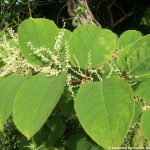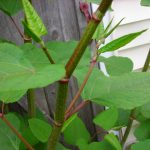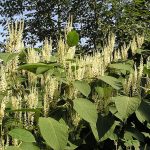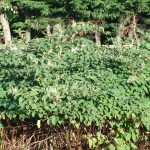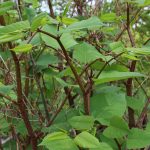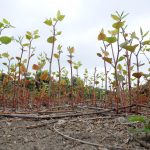
Identification & Removal
Japanese Knotweed Identification & Removal
Japanese knotweed & identification, first you need to identify the plant – so what is it? Japanese knotweed (Fallopia japonica) and its hybrids are a non-native, invasive species of plant. Since it was introduced into the UK as an ornamental garden plant in the mid-nineteenth century, it has spread across the UK, particularly along watercourses, transport routes and infested waste areas and of course private gardens.
Plants within their native range are usually controlled by a variety of natural pests and diseases. When plants such as this are introduced into new areas, that are free from these pests and diseases, they can become larger and more vigorous. They invade natural habitats and out-compete the native plants and animals that normally live there. Rivers, hedges, roadsides and railways form important corridors for native plants and animals to migrate, and large infestations of non-native weeds can block these routes for wildlife
What does Japanese knotweed look like?
Japanese knotweed is a rhizomatous (produces underground foraging stems) perennial plant with distinctive branching, hollow, bamboo-like stems, covered in purple speckles, often reaching 2-3 m high. The leaves of the mature plant are up to 120 mm in length with a flattened base and pointed tip and are arranged on arching stems in a zig-zag pattern.
The plant flowers late in the season, August to October, with small creamy-white flowers. The rhizome system may extend to, and beyond, a depth of at least 2m and extend 7m laterally from a parent plant. During winter, the leaves die back to reveal orange/brown coloured woody stems which may stay erect for several years. Stem and leaf material decomposes slowly, leaving a deep layer of plant litter.
During March to April, the plant sends up new shoots, red/purple in colour with rolled back leaves. These shoots grow rapidly due to stored nutrients in the extensive rhizome system. Growth rates of up to 40 mm a day have been recorded.
Why is Japanese Knotweed such a problem?
Japanese Knotweed is a fast growing, invasive plant and can cause problems in both Urban and Rural areas. The plant damages the urban environment such as gardens and road verges, by pushing up through tarmac and paving, out-competing other species in the area causing both aesthetic problems, such as ruining garden landscapes and also structural problems, such as when the plant grows into walls and cracks, pushing them apart.
As well as rendering a property as ‘unmortgagable’ by the majority of the UK major lenders, the following are areas of residential property that can be adversely affected by the presence of Japanese Knotweed. Although these are the worst case scenarios it is worth considering when dealing with this invasive weed.
Drains and other buried services
Knotweed rhizomes can exploit existing cracks and gaps in the pipes in their search for water, which will further damage and, in some cases, block the drains. Large, densely packed clumps or ‘stands’ of Japanese Knotweed can disrupt drain runs. In the worst cases, the drains must be rebuilt.
Patios, paths and drives
Japanese Knotweed can grow between slabs and movement joints of concrete drives and disrupt brick paving. Repairs can involve the removal of the existing paving and bedding material, treatment of the plant, removal of the disruptive crowns and roots and replacement of the path, patio or drive.
Boundary and retaining walls
Closely packed growth can push its way under garden walls with shallow foundations. The mass of the stands can ‘push over’ retaining walls, often resulting in sudden collapse.
Outbuildings
Vigorous stands of Japanese Knotweed can overwhelm lightweight, insubstantial and poorly founded outbuildings such as garden sheds, greenhouses and in some cases, poorly built garages.
Conservatories
Although the effects will be similar to those described for outbuildings, owners, valuers and surveyors usually attribute greater importance to these structures.
Gardens
The invasive nature of the plant can ruin well-planned and well-stocked gardens. Some owners spend tens of thousands of pounds on renovating and redesigning outside spaces, including sophisticated water features and bespoke outbuildings.
The plant can be very easily spread and in the UK the plant is mainly spread through rhizome fragments or cut stems. Greenhouse trials have shown that as little as 0.7 gram (finger nail) of rhizome material can produce a new plant within 10 days. Cut fresh stems have also been shown to produce shoots and roots from nodes when buried in soil or immersed in water. Once cut stem material has been allowed to dry out thoroughly and has reached the orange/brown ‘woody’ stage, there is no further regeneration. Rhizome material may take much longer to die and may remain dormant for long periods, possibly as long as 20 years.
The spread of Japanese knotweed is a serious threat to our countryside, and the native plants and animals that rely upon it. Tackling the plant should be taken very seriously with thorough planning and execution if we are to combat this invasive weed.

